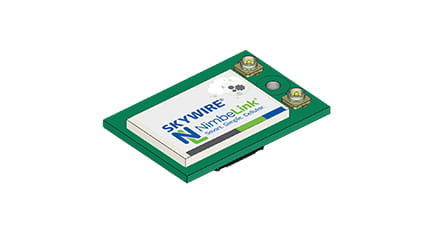Smart metering
Build utility meters that will operate trouble-free for decades with Nordic

Nordic Semiconductor today announces that cellular IoT products and applications can now be brought to market in days using the first publicly-announced third-party modem to be based on the Nordic multi-mode LTE-M/NB-IoT nRF9160 SiP.
Called the Skywire® Nano, the NimbeLink modem enables this by having achieved ‘end device certification’ for use on both LTE-M and NB-IoT cellular IoT networks worldwide. This means any product or application using the modem doesn’t have go through the normal carrier certification process.
“Nordic Semiconductor has always been known as the low-power leader in wireless radios,” comments Kurt Larson, CTO of NimbeLink. “And the nRF9160 SiP clearly exhibits the company’s ‘low-power-first’ mentality during its design process, resulting in a cellular SiP that is leaps ahead of any product offered by all the other cellular IoT providers in terms of its miniaturized size and low power consumption. The Skywire Nano leverages this to the max to achieve the tiniest 15 x 22 x 5mm (estimated) form-factor and lowest power consumption of any cellular IoT modem available on the market today.”

Larson continues: “We also really liked the way the Nordic nRF9160 DK design kit enabled us to embed our own code within the nRF9160’s on-board 64MHz Arm® Cortex™-M33 applications processor in an extremely low power way. By that I mean other vendors provide applications processors, but their SDKs are not as streamlined as the Nordic nRF9160 DK and can’t reach the same low power states.”
The Skywire Nano gives users access to the Nordic nRF9160’s Arm® Cortex™-M33 CPU with 1MB of flash and 256KB of RAM; has UART, SPI, and I2C serial interfaces; a soldered-down Verizon SIM; support for external SIM sockets; a simple firmware over-the-air (OTA) update system; an easy GSMA network back-off solution; AT command interface for UDP and TCP/IP socket dials; and GNSS support.
NimbeLink says customers can also select their own antenna (within some broad guidelines) for use with their modem without affecting its pre-certified status. “This means if a customer isn’t happy with the performance, they can use a different antenna or put the antenna in a better place within their product or application” adds Larson.
NimbeLink says its Skywire Nano modem will be available during Q1 2020.
“Third-party modems make a lot of sense when existing production volumes have yet to scale and in situations where a company wants to test market acceptance before investing further design resources,” comments Geir Langeland, Nordic Semiconductor Director of Sales & Marketing. “But above all else, cellular IoT modems further simplify the already simple design process Nordic Semiconductor works so hard to achieve in all its products, and so are a valuable option in the highly diversified global IoT market.”
Build utility meters that will operate trouble-free for decades with Nordic